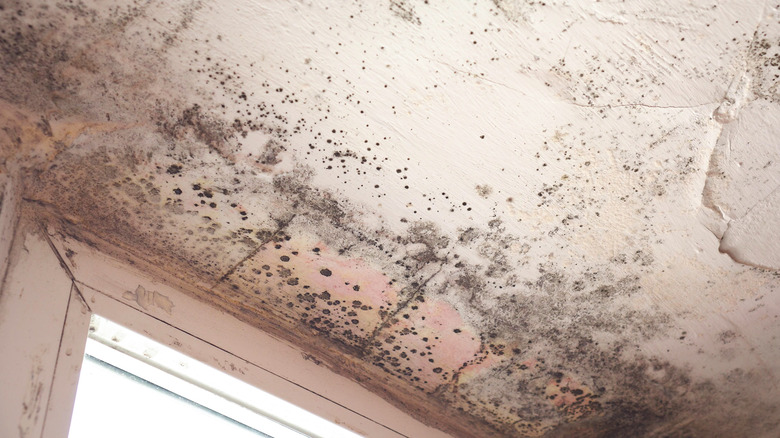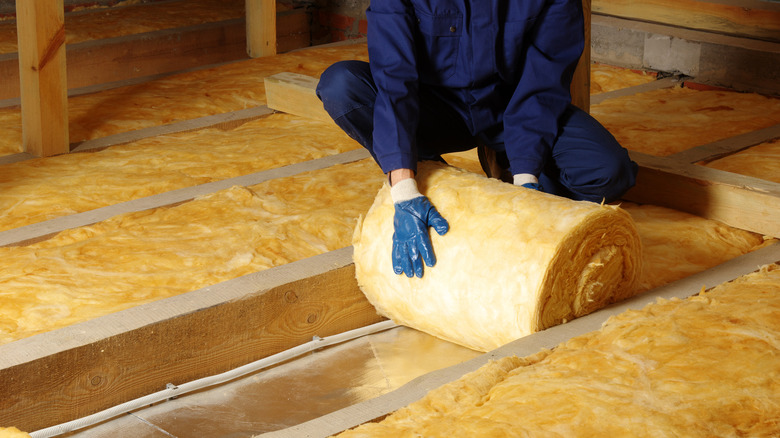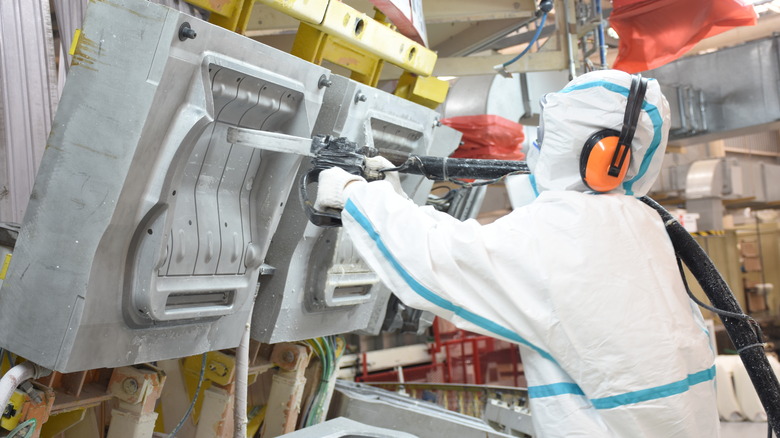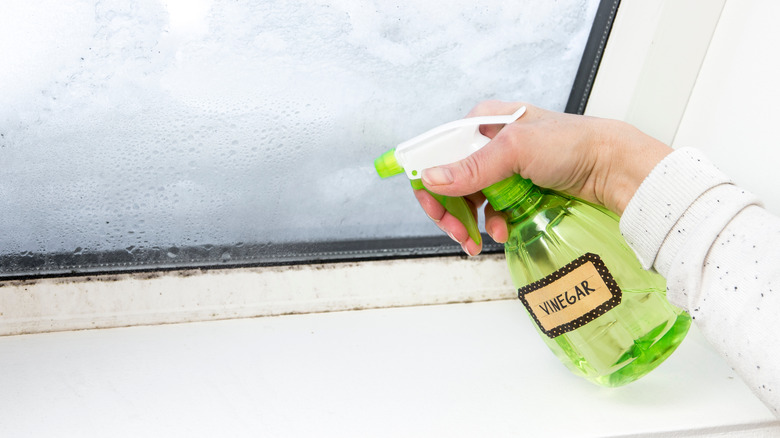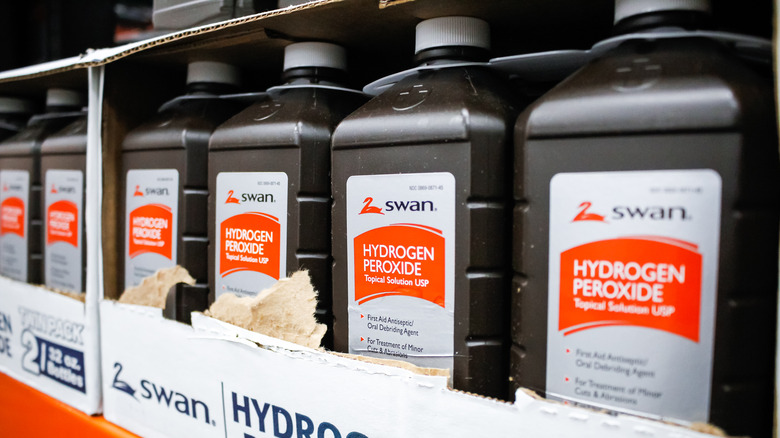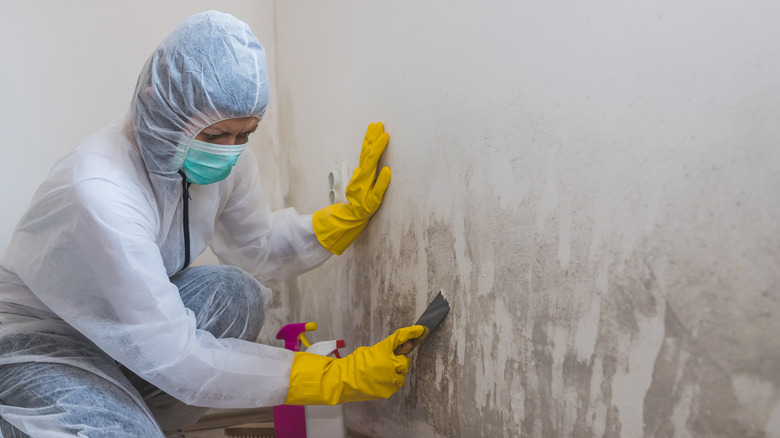How To Eliminate Dangerous Mold Lurking In Your Attic
According to Mold Solutions, there are several types of mold that can grow in your home, but the most dangerous is stachybotrys chartarum, otherwise known as black toxic mold. Black toxic mold typically grows in dark areas of the home, specifically in basements and attics. This is different from black-colored mold, which isn't necessarily toxic but can cause allergy symptoms, such as watery eyes and an itchy throat. On the other hand, black toxic mold can lead to serious health issues if not dealt with immediately. Symptoms of black toxic mold poisoning may include irritated eyes, chronic coughing and sneezing, and persistent headaches.
If a person is exposed to the mold for an extended period of time, they may develop life-threatening symptoms (per Mold Solutions,) such as heart damage, blood clotting, and internal or external hemorrhaging. While it does sound scary, you can avoid these issues by eliminating dangerous mold before it spreads and makes things worse. The good thing is that the process isn't too difficult, and in most cases, black mold can be removed without professional help.
Prevention is key
In order to prevent mold, you need to understand how and why it grows. Mold is most commonly found in attics because of moisture and poor ventilation, PuroClean explains. Perhaps, you have a leaky roof, or your exhaust fans are spewing hot, moist air all over your attic. During the winter, your attic may exhibit microbial issues because of the condensation created by high relative humidity and cold surfaces. No matter what season, if the mold isn't dealt with right away, it can build up in your attic and cause problems for your health and your home.
To prevent buildup, Mold Help For You suggests inspecting your attic for signs of mold roughly every three months. Use this time to look for signs of any leaks in the roof or built-up moisture that may lead to mold growth. You should also ensure your ventilation is working properly to keep moisture out.
Dry ice blasting
A very effective way to eliminate the dangerous mold lurking in your attic with dry ice blasting — what is dry ice blasting? According to Brothers In Grime, it's the method most used among remediation specialists, but the machine is available to any homeowner. During dry ice blasting, the mold is diffused with carbon dioxide at -78 degrees celsius. Freezing temperatures and a chemical reaction between the CO2 and the mold causes the mold to shrink and detach from whatever surface it's clinging to. Moreover, dry ice blasting also prevents mold from growing back.
There are actually several additional benefits to dry ice blasting besides mold removal. Cold Jet says dry ice blasting can remove soot and smoke damage, and eliminate any lingering odors in your attic. It's a great method for cleaning hard-to-reach spots without damaging sensitive or delicate surfaces, and since it's a dry cleaning process, you don't need to worry about trapping moisture in.
Vinegar and baking soda
After accessing the mold situation in your attic, if you think you can handle it without a professional, you can use vinegar and baking soda to eliminate the mold. Before you do anything, keep yourself safe by wearing non-porous gloves, goggles or safety glasses, and most importantly, a protective face mask – Atkinson Inspection Services recommends an N95. Once you've properly prepared yourself for safe mold removal, Merry Maids suggests spraying the entirety of the mold with undiluted white vinegar and letting it sit for an hour so the vinegar can fully penetrate the mold.
After 60 minutes or so, make a simple baking soda solution using 1/2 teaspoon of baking soda and 2 cups of water. Saturate the mold with the mixture using a spray bottle, then scrub it away. Keep in mind this is not a permanent solution, and you'll need to locate the source of the mold to prevent it from growing back.
Hydrogen peroxide
You may think bleach is the be-all, end-all of cleaning products, but when it comes to mold, that is definitely not the case. According to Branch Environmental, using bleach to remove the mold in your attic is a waste of time. Bleach kills bacteria, not mold. Using bleach to remove mold is the same thing as spraying bleach on the debris on your kitchen floor — pointless. Sure, bleach will kill any bacteria living in the mold, but that doesn't mean it's going to eliminate the mold itself.
Instead of bleach, use hydrogen peroxide to remove the mold from your attic. To do this, simply spray the mold with hydrogen peroxide and let it sit for 10 to 15 minutes. Afterward, scrub the mold until it's gone, then rinse well with clean water. For more stubborn areas, you may need to repeat this process a few times until your attic is mold-free.
Call a professional
No matter how hard you try, sometimes you just need a professional to fix the problem, especially when the problem is a threat to the health of yourself and others. If you can't decide if the problem is severe enough to call a mold remediation specialist, ServiceMaster Clean says you can never be too careful when it comes to mold. Some restoration companies offer free consultations, so you don't need to worry about paying a cent unless a professional recommends a course of action. Not only do mold removal specialists have more knowledge about mold and locating its source, but professionals also have the necessary equipment needed for its correct removal.
If you want to skip the consultation, Modernistic says an easy way to determine the severity of the mold is by its square footage. If the growth is 10 square feet or more, call a mold removal specialist as soon as possible.
